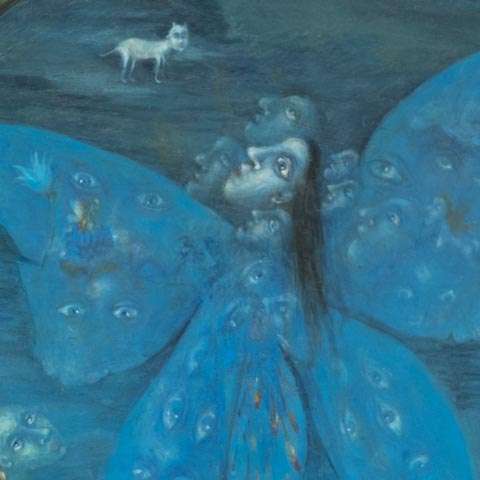
RARITIES
PURYGIN Leonid Anatolyevich (1951–1995) Butterfly. 1989. Oil on wood. 41 × 33
A wonderful chamber work by the famous nonconformist artist. He signed “Lenya Purygin from Nara”. Sometimes he added “Ingenious”. A self-taught artist from the drawing circle of the Naro-Fominsk Palace of Culture (that same Nara) is now one of the most expensive artists of the post-war unofficial art. His record is 177 thousand dollars.
What is Purygin appreciated for? For a special look, for a fantasy fairytale world inhabited by deep philosophical characters. An artist of a very difficult fate. He drank heavily, was in mental hospitals, participated in apartment exhibitions. In 1988, foreign collectors noticed Purygin at the first Moscow Sotheby's, and soon the artist left for America. But he didn't take root there. He returned to Russia and in 1995 died of a heart attack.
We have presented very delicate work: people-butterflies, people-cats, people-moths, striving upward. And the signature: “Lenya Purygin from Nara”. The painting is sold with the expertise of Valery Silaev. The expert separately emphasized that the work is of museum importance.
VLADIMIR SCHOOL
BRITOV Kim Nikolaevich (1925–2010) March day. 1970s. Oil on canvas mounted on cardboard. 30 × 40
Winter, or rather spring fishing. A song about Russian hunting, freedom-captivity, but with elements of Russian maybe. Britov. The main classic of the Vladimir school. Assertive, bright. Number one. Many consider him to be the inventor and founder. But experts in the Vladimir school say that a much less famous artist, Vladislav Potekhin, stood at the origins of this trend. From one of his summer creative assignments, he brought from the south his painting, executed in a bold open hyper-color style. Nobody wrote like that in the USSR. And this creative find inspired several like-minded artists in Vladimir. The painting of Kim Britov “March Day” is accompanied by the opinion of the expert on the Vladimir school Nadezhda Sevastyanova.
NONCONFORMIST ART
NEY Alexander (1939) Skull. Terracotta, paint. 9 × 10 × 15
Skulls, heads — this is one of the favorite subjects in the work of Alexander Nezhdanov, known under the American pseudonym Ney. Why? We once inadvertently assumed that Ney's skulls were inspired by the skulls in the work of his friend in Leningrad times, Mikhail Chemiakine. But the artist, having learned about this, wrote to us that it was not so. The source of inspiration was Bilibin's painting “Vasilisa the Beautiful leaves Baba Yaga's hut”, where Vasilisa illuminates the road with light from the eyes of a skull on a stick.
However, our skull is completely devoid of something sinister. On the contrary. It is decorative and trendy. Combines Takashi Murakami's humor and Damien Hirst's point theme. An excellent compact collectible.
NEMUKHIN Vladimir Nikolaevich (1925–2016) Three-dimensional composition. 2000. Wood, paint. 45 × 14 × 14
The large, spectacular signature sculpture belongs to the cycle of Nemukhin's works, where he turns to the nature of form, to the meaning of movement, to the ideas of Russian constructivism. Tatlin Tower? Or the ideas of kineticists — friends from the Movement group?
Not. Like the theme of cards (more on that next time), it was born not as a product of dry analytical work, but as a result of one vivid natural impression. Paradoxically, this sculpture is the essence of the impressionism. In 2018, art critic Elena Vladimirova recorded Nemukhin's memories of the appearance of this particular thing. It turns out that once on the banks of the Oka in Priluki, the artist saw a linden tree destroyed by a lightning strike. The tree didn't burn, it just exploded. The trunk was exposed, and the bark (bast) came off the trunk and hung in stripes. Fascinated by the beauty of this destruction, Nemukhin created a geometric sculpture. And he called it simply — “Three-dimensional composition”. The work is signed. The familiar НВ / Вл. Немухин / 2000 stands on the base.
RARITIES
GRIGORIEV Boris Dmitrievich (1886–1939) Beach. 1933. Pencil, watercolor on paper. 33 × 41.5
Boris Grigoriev is known for his merciless deep philosophical portraits. Whether it's the image of a harbor prostitute or a great cultural figure... Blok called Boris Grigoriev an artist who “thinks deeply and destructively”. Grigoriev is a world-famous master, he is still one of the most expensive Russian artists. 1930s — this is the late Grigoriev, French period. The artist fled Russia in 1919 (they say that he himself transported the family by boat across the Gulf of Finland) and a few years later settled in his own villa in Provence. So the beach depicted in the 1933 drawing is most likely the Cote d'Azur. Hitler has already become the Reich Chancellor of Germany. France has less than seven years left before the occupation. But nobody knows about this yet. Have fun, sunbathe, enjoy life. Provenance: collection of Valery Dudakov and Marina Kashuro.
KAPITANOVA (ARAPOVA) Julia Grigorievna (1889–1976) Double portrait. J. G. Kapitanova and A. A. Arapov. 1950s. Canvas, oil. 62 × 55
Julia Kapitanova, she is Julia Arapova, she is Julian Koltsov. Koltsov is the pseudonym under which she exhibited. And she was married to Arapov — also a famous artist. Julia Kapitanova is known as a colleague of Pavel Filonov and as a fatal figure for his group “Masters of Analytical Art”. It is believed that it was Arapova who quarreled among Filonov's team-mates and students. Her protest against the “dictatorship” of the old team-mates in Filonov's workshop caused a split in the “Masters of Analytical Art” group. Although others complained about her difficult character, which, along with talent, was noted by Filonov himself. As a result of the conflict in 1930, some people left the Filonov group, and Kapitanova remained with the master. Although not for long. In the second half of the 1930s, Arapova, together with her husband, worked on the design of the performances. By the way, this picture just depicts Kapitanova and Arapov. Signed with initials in the right corner ЮА.
- Log in to post comments










